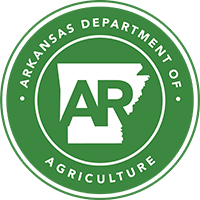Department of Agriculture
Supporting Arkansas farmers and ranchers while ensuring safe food, fiber, and forest products for the citizens of Arkansas, the nation, and across the globe
Agriculture / Highly Pathogenic Avian Influenza
Highly Pathogenic Avian Influenza
Highly pathogenic avian influenza (HPAI) is caused by an influenza type A virus which can infect poultry and wild birds. HPAI virus strains are extremely infections, often fatal to chickens, and can spread rapidly from flock to flock. There are no treatments or vaccines available to control avian influenza. The only available control is depopulation all affected and exposed flocks. Signs can include:
- Sudden increase in bird deaths without any clinical signs
- Decreased water and feed intake
- Lack of energy
- Decrease in egg production
- Soft or thin-shelled or misshapen eggs
- Swelling of the head, eyelids, comb, wattles, and hocks
- Purple discoloration of the wattles, comb, and legs
- Gasping for air (difficulty breathing)
- Coughing, sneezing, and/or nasal discharge (runny nose)
- Stumbling or falling down
- Diarrhea
Poultry owners should monitor their flocks and report any possible symptoms to the Arkansas Department of Agriculture at 501-823-1746.
Wild birds that are infected can shed the virus at high levels in their manure. One gram of contaminated manure can infect one million birds. There are a few measures you can take to keep your backyard or commercial flocks safe:
- Clean: Wash your hands, change or clean your shoes, and disinfect any equipment before and after entering your flock area. Avian influenza virus can survive in manure for several weeks, especially with high moisture and low temperatures.
- Cover: Restrict flocks from sharing their habitat with wild waterfowl by maintaining outdoor enclosures with roofs or tarps and wire mesh or netted sides. Repair any holes or tears that would allow wild birds or rodents to enter.
- Isolate: Keep track of everyone who comes onto your property at all times by using a logbook. If they had contact with other poultry, have pet birds, or had contact with wild birds (e.g., hunting), do not let them come in contact with your flock. Consider hanging a bird deterrent near the poultry houses to keep away wild birds that may infect your flock. Quarantine new birds for at least two weeks before introducing to your flock.
Avian Influenza Flyer Translations:
- Avian Flu Alert Flyer English Version
- Avian Flu Alert Flyer Hmong Version
- Avian Flu Alert Flyer Marshallese Version
- Avian Flu Alert Flyer Spanish Version
The United States Department of Agriculture (USDA) provides resources on biosecurity for poultry operations through their Defend the Flock campaign, which can be found here.
More information on HPAI can be found here.
Frequently Asked Questions
What is avian influenza?
Avian influenza is caused by an influenza type A virus which can infect poultry (such as chickens, turkeys, pheasants, quail, ducks, geese, and guinea fowl) and wild birds (especially waterfowl).
Can humans get the virus?
Bird flu viruses do not normally infect humans.
Does the virus impact our food?
As part of the USDA highly pathogenic avian influenza response plan, infected birds do not enter the food supply. All poultry products for public consumption are inspected for signs of disease both before and after slaughter.
How is avian influenza spread?
Avian influenza can be spread in two main ways: directly from infected birds or contaminated environments or indirectly through an intermediate host.
What is the economic impact of HPAI on Arkansas?
HPAI poses a substantial economic risk to the poultry and agriculture industries in Arkansas.
What are the different types of avian influenza?
Low pathogenicity avian influenza (LPAI) virus strains occur naturally in wild migratory waterfowl without causing illness. LPAI can infect domestic poultry, creating little or no signs of illness. Highly pathogenic avian influenza (HPAI) virus strains are extremely infectious, often fatal to chickens, and can spread rapidly from flock-to-flock.
What are the signs of avian influenza?
Signs of avian influenza can include:
- Sudden increase in bird deaths without any clinical signs
- Decreased water and feed intake
- Lack of energy
- Decrease in egg production
- Soft, thin-shelled, or misshapen eggs
- Swelling of the head, eyelids, comb, wattles, and hocks
- Purple discoloration of the wattles, comb, and legs
- Gasping for air (difficulty breathing)
- Coughing, sneezing, and/or nasal discharge (runny nose)
- Stumbling or falling down
- Diarrhea
What should I do if I suspect avian influenza in my poultry?
Poultry owners should monitor their flocks and report any possible symptoms to the Arkansas Department of Agriculture at 501-823-1746.
What happens if the virus is confirmed in my flock?
If the virus is confirmed in your flock, all affected and exposed flocks must be depopulated.
How can I protect my flock?
Because there are no treatments or vaccines available to control avian influenza, it is important for poultry owners to monitor their flocks and increase biosecurity measures. Some tips to follow to keep your flock safe include:
- Clean: Wash your hands, change or clean your shoes, and disinfect any equipment before and after entering your flock area. Avian influenza virus can survive in manure for several weeks, especially with high moisture and low temperatures.
- Cover: Restrict flocks from sharing their habitat with wild waterfowl by maintaining outdoor enclosures with roofs or tarps and wire mesh or netted sides. Repair any holes or tears that would allow wild birds or rodents to enter.
- Isolate: Keep track of everyone who comes onto your property at all times by using a logbook. If they had contact with other poultry, have pet birds, or had contact with wild birds (e.g., hunting), do not let them come into contact with your flock. Consider hanging a bird deterrent near the poultry houses to keep away wild birds that may infect your flock. Quarantine new birds for at least two weeks before introducing to your flock.
How can I help in the effort to stop the spread of avian influenza?
Increased biosecurity is the best defense against avian influenza. If you are a poultry owner, increase biosecurity at your operation or in your backyard flock. Keep visitors to a minimum, clean or disinfect your shoes before entering and after exiting your flock area, and cover your flocks with roofs or tarps to avoid exposure to wildlife.
What is the testing process for avian influenza?
Initial avian influenza screening tests are performed by one of more than 45 USDA-approved laboratories in the National Animal Health Laboratory Network (NAHLN). In the case of wild bird samples, the United States Department of the Interior National Wildlife Health Center also performs initial screening tests. These labs will determine if the avian influenza virus is present and whether it is an H5 or H7 subtype. Because of the potential for H5 or H7 subtypes to mutate into highly pathogenic strains, those samples are forwarded to USDA's National Veterinary Services Laboratories (NVSL) for confirmatory tests, with research assistance from USDA's Southeast Poultry Research Lab.
This USDA laboratory in Ames, Iowa, is the only avian influenza reference laboratory in the United States recognized by the World Organization for Animal Health, known as the OIE. Although there is a network of laboratories across the nation approved to conduct avian influenza screening tests, confirmatory testing in the United States is conducted at NVSL.
Read more about the testing process here.

